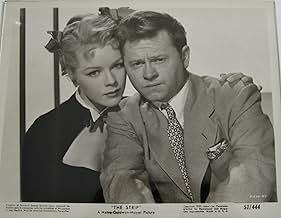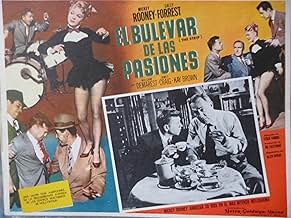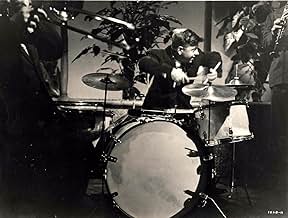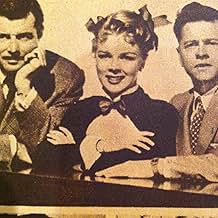Ajouter une intrigue dans votre langueDrummer Stanley Maxton moves to Los Angeles with dreams of opening his own club, but falls in with a gangster and a nightclub dancer and ends up accused of murder.Drummer Stanley Maxton moves to Los Angeles with dreams of opening his own club, but falls in with a gangster and a nightclub dancer and ends up accused of murder.Drummer Stanley Maxton moves to Los Angeles with dreams of opening his own club, but falls in with a gangster and a nightclub dancer and ends up accused of murder.
- Nommé pour 1 oscar
- 1 nomination au total
Avis en vedette
The Strip marked Mickey Rooney's return to MGM after he had left in 1948 and the property was considerably down from what he was used to. Still The Strip is a nifty little noir film from MGM's B Picture unit that managed to earn itself one Academy Award nomination.
In The Strip Mickey finds himself a returning Korean War veteran who wants to get back into civilian life and he meets up with gangster James Craig, a rather smooth individual who 'sells insurance'. Mickey works for him in some non-violent occupations and Craig actually lets him leave to pursue his real dream of being a drummer. But Mickey finds himself falling big time for Craig's girlfriend Sally Forrest and that's where his problems begin.
The film is structured like Mildred Pierce with Mickey hauled into police headquarters because one of the cast has been found murdered and another hanging on for dear life. He relates his story to detective Tom Powers and we see the tale unfold.
The Strip is also a nice look at the jazz club life in Los Angeles of that period. Where Rooney winds up working is William Demarest's jazz club on Sunset Boulevard better known as The Strip. The film also gives us an exhibition of one of Mickey Rooney's many talents, that of a drummer. He shows that if he pursued and concentrated on that he could have been another Buddy Rich or Gene Krupa. And the chance to jam with such people as Louis Armstrong and Jack Teagarden must have been what sold the Mick on doing this film.
Guest starring in The Strip are singers Vic Damone and Monica Lewis, but the best thing about The Strip is the song A Kiss To Build A Dream On. That was the last song written by the celebrated Tin Pan Alley duo of Harry Ruby and Bert Kalmar. It was an unfinished theme because Kalmar had died a few years earlier. To finish the lyric Ruby called on none other than Oscar Hammerstein, II and the combined talents of those three people earned an Oscar nomination for Best Original Song for 1951. It lost however to In The Cool Cool Cool Of The Evening, Bing Crosby and Jane Wyman's hit from Here Comes The Groom. Louis Armstrong made a big hit record of it back in that day, you could hear it on jukeboxes for years.
I'm sure it was of some satisfaction to Rooney that he made a small B film so much better with his incredible talent for his former home studio. That and a wonderful song attached to The Strip make it fine entertainment still.
In The Strip Mickey finds himself a returning Korean War veteran who wants to get back into civilian life and he meets up with gangster James Craig, a rather smooth individual who 'sells insurance'. Mickey works for him in some non-violent occupations and Craig actually lets him leave to pursue his real dream of being a drummer. But Mickey finds himself falling big time for Craig's girlfriend Sally Forrest and that's where his problems begin.
The film is structured like Mildred Pierce with Mickey hauled into police headquarters because one of the cast has been found murdered and another hanging on for dear life. He relates his story to detective Tom Powers and we see the tale unfold.
The Strip is also a nice look at the jazz club life in Los Angeles of that period. Where Rooney winds up working is William Demarest's jazz club on Sunset Boulevard better known as The Strip. The film also gives us an exhibition of one of Mickey Rooney's many talents, that of a drummer. He shows that if he pursued and concentrated on that he could have been another Buddy Rich or Gene Krupa. And the chance to jam with such people as Louis Armstrong and Jack Teagarden must have been what sold the Mick on doing this film.
Guest starring in The Strip are singers Vic Damone and Monica Lewis, but the best thing about The Strip is the song A Kiss To Build A Dream On. That was the last song written by the celebrated Tin Pan Alley duo of Harry Ruby and Bert Kalmar. It was an unfinished theme because Kalmar had died a few years earlier. To finish the lyric Ruby called on none other than Oscar Hammerstein, II and the combined talents of those three people earned an Oscar nomination for Best Original Song for 1951. It lost however to In The Cool Cool Cool Of The Evening, Bing Crosby and Jane Wyman's hit from Here Comes The Groom. Louis Armstrong made a big hit record of it back in that day, you could hear it on jukeboxes for years.
I'm sure it was of some satisfaction to Rooney that he made a small B film so much better with his incredible talent for his former home studio. That and a wonderful song attached to The Strip make it fine entertainment still.
These types off film were being hammered out weekly in the 1950's. Superficially, there is little to distinguish this from the rest. However as it progresses, there is much to admire and enjoy. I love the format of an a hour and a quarter running time. Long enough to tell a simple tale, but without any time for padding, every frame counts.
Mickey Rooney is a fine character actor. One of the minor amusements here is watching a diminutive Rooney playing the lead, being dwarfed by everyone apart from his leading lady, Sally Forrest, who is probably the only actor on screen smaller than him! The premise of the loser/little guy who stands up for himself works well with several acutely observed scenes. The tragic denouement is a genuine surprise and is well told with clever editing keeping the tale skimming along at a brisk pace.
The musical,and song and dance interludes provide pleasing pauses in the action resulting in a film that ultimately delivers because it works so conspicuously within it's boundaries, rather than trying to push them.
Mickey Rooney is a fine character actor. One of the minor amusements here is watching a diminutive Rooney playing the lead, being dwarfed by everyone apart from his leading lady, Sally Forrest, who is probably the only actor on screen smaller than him! The premise of the loser/little guy who stands up for himself works well with several acutely observed scenes. The tragic denouement is a genuine surprise and is well told with clever editing keeping the tale skimming along at a brisk pace.
The musical,and song and dance interludes provide pleasing pauses in the action resulting in a film that ultimately delivers because it works so conspicuously within it's boundaries, rather than trying to push them.
Mickey Rooney as discharged Korean War veteran Stanley Maxton not only gets a chance to act as a grown up out on his own in the big city of L.A the movie "The Strip" also showcases his ability to play the drums which he's very good at.
The story in itself is more or less average with Stan getting in with the wrong crowd. later when he meets pretty Jane Tafford, Sally Forrest, as he was running from the L.A vice squad. Stan falls so madly in love with the "Fluff's" nightclub cigarette girl and part-time dancer that he quits his job working for local mobster Sonny Johnson, James Craig,to work full-time as a drummer with the Louie Armstrong band at the club.
We already know before were even introduced to Stan that Jane is badly injured and dying in the hospital and Sonny is dead from a gunshot wound as the movie started. In a "Dragnet" like introduction we see a police car pull up at Jane's apartment in L.A finding her on the floor bleeding to death. Stan later picked up at his pad is taken to the police station and quizzed about both, Jane & Sonny's, shooting. The film then goes into a long flashback to how this whole tangled and deadly affair began. Stan wasn't too bright in his falling for Jane's obvious attempt to exploit his connections with big time mobster Sonny Johnson.
Sonny promising to get Jane a screen test and a short-cut into the movies as an actress had the star-struck Jane fall for Sonny's line that he knows people in high places in Hollywood, hook line and sinker. Jane then dropped Stan who thought that she was in love with him like a hot potato. Sonny also wasn't that fond of Stan checking out on him to work for Fluff's and sent two of his goons to Stan's place to first talk him into coming back and later work him over for not being too cooperative.
Stans later warning Jane about Sonny's involvement with the mob backfired when she went to have it out with him about his stringing her along and getting her nowhere in the movies which resulted in his being shot and killed and her ending up on life-support. At the police station Stan in another one of his hair brain attempts to get Jane to come back to him confessed to killing Sonny. It's then that he's told later by L.A police Detective Let. Bonnablo, Tom Powers, that she already confessed to the killing in a typed statement and didn't survive her injuries. Even there with him wanting to take the rap for Jane Stan ended up looking like a total jerk.
What I thought was the biggest boner that Stan made in the movie, and he made a lot of them, was him not noticing how Edna, Kay Brown, another girl who worked at "Fluff's" was absolutely crazy about him and how he just shoved her off every time she tried to make the slightest attempt to talk and get friendly with him. Edna who for some reason was called "kid" by everyone in the film, I had to find out what her name was in the IMDb credits, was as pretty, if not more so, then Jane and much nicer and kinder to Stan. But as usual, like with everything else he did in the movie, Stan completely overlooked a good thing when he saw one by being blind to the feelings that she had for him. Even when she was right in front of Stan sweetly asking him for a date!
The story in itself is more or less average with Stan getting in with the wrong crowd. later when he meets pretty Jane Tafford, Sally Forrest, as he was running from the L.A vice squad. Stan falls so madly in love with the "Fluff's" nightclub cigarette girl and part-time dancer that he quits his job working for local mobster Sonny Johnson, James Craig,to work full-time as a drummer with the Louie Armstrong band at the club.
We already know before were even introduced to Stan that Jane is badly injured and dying in the hospital and Sonny is dead from a gunshot wound as the movie started. In a "Dragnet" like introduction we see a police car pull up at Jane's apartment in L.A finding her on the floor bleeding to death. Stan later picked up at his pad is taken to the police station and quizzed about both, Jane & Sonny's, shooting. The film then goes into a long flashback to how this whole tangled and deadly affair began. Stan wasn't too bright in his falling for Jane's obvious attempt to exploit his connections with big time mobster Sonny Johnson.
Sonny promising to get Jane a screen test and a short-cut into the movies as an actress had the star-struck Jane fall for Sonny's line that he knows people in high places in Hollywood, hook line and sinker. Jane then dropped Stan who thought that she was in love with him like a hot potato. Sonny also wasn't that fond of Stan checking out on him to work for Fluff's and sent two of his goons to Stan's place to first talk him into coming back and later work him over for not being too cooperative.
Stans later warning Jane about Sonny's involvement with the mob backfired when she went to have it out with him about his stringing her along and getting her nowhere in the movies which resulted in his being shot and killed and her ending up on life-support. At the police station Stan in another one of his hair brain attempts to get Jane to come back to him confessed to killing Sonny. It's then that he's told later by L.A police Detective Let. Bonnablo, Tom Powers, that she already confessed to the killing in a typed statement and didn't survive her injuries. Even there with him wanting to take the rap for Jane Stan ended up looking like a total jerk.
What I thought was the biggest boner that Stan made in the movie, and he made a lot of them, was him not noticing how Edna, Kay Brown, another girl who worked at "Fluff's" was absolutely crazy about him and how he just shoved her off every time she tried to make the slightest attempt to talk and get friendly with him. Edna who for some reason was called "kid" by everyone in the film, I had to find out what her name was in the IMDb credits, was as pretty, if not more so, then Jane and much nicer and kinder to Stan. But as usual, like with everything else he did in the movie, Stan completely overlooked a good thing when he saw one by being blind to the feelings that she had for him. Even when she was right in front of Stan sweetly asking him for a date!
If you like jazz, you'll like this one : there's a good part of this movie which takes place in Los Angeles' night-clubs with guest star Louis Armstrong. The story may look classical for a film noir, but the way it shows the story of a drummer penetrating in the underground world is surprising : watch it especially for the drum solos. Enjoyable !
Rootless kid (Rooney) goes to LA, hooks up with a smooth-talking mobster (Craig) and an ambitious nightclub dancer (Forrest), and gets into trouble as a result.
Despite its odd parts, this little b&w adds up to a pretty entertaining whole. The numbers from jazz legends Louis Armstrong and Jack Teagarden should please even those who don't much care for that style. Rooney of course is Rooney, a little man in a big man's world. No longer Andy Hardy, he was increasingly difficult to cast despite continuing popularity. Here his connection to mobster Craig is quite a stretch. Too bad the screenplay couldn't work out something more plausible. Nonetheless, his performances are never boring, plus he's a real firecracker on the drums.
And who's expert inspiration was it to stick roughneck William Demarist with the impossible name "Fluff". In my book, his avuncular nightclub owner walks off with the film. Sally Forrest makes for a convincingly ambitious Hollywood wannabe and romantic foil for Rooney. Looks like her movie misfortune was to be short and bouncy at a time when Debbie Reynolds was getting a hammerlock on spunk. Speaking of cute, did they have to make the wholesome girl (Kay Brown, I think) quite so achingly sweet and vulnerable.
Film is also a promo for nightspots along the Sunset Strip, where Vic Damone, for one, performs. And that's a few years before the big TV hit 77 Sunset Strip, which also exploited Hollywood nightlife. Location filming here adds atmosphere and a good glimpse of tinsel town, circa 1950 , along with the tuneful theme A Kiss to Build a Dream On. Anyway, in spite of real flaws, it's still an entertaining little film with a very appropriate ending.
Despite its odd parts, this little b&w adds up to a pretty entertaining whole. The numbers from jazz legends Louis Armstrong and Jack Teagarden should please even those who don't much care for that style. Rooney of course is Rooney, a little man in a big man's world. No longer Andy Hardy, he was increasingly difficult to cast despite continuing popularity. Here his connection to mobster Craig is quite a stretch. Too bad the screenplay couldn't work out something more plausible. Nonetheless, his performances are never boring, plus he's a real firecracker on the drums.
And who's expert inspiration was it to stick roughneck William Demarist with the impossible name "Fluff". In my book, his avuncular nightclub owner walks off with the film. Sally Forrest makes for a convincingly ambitious Hollywood wannabe and romantic foil for Rooney. Looks like her movie misfortune was to be short and bouncy at a time when Debbie Reynolds was getting a hammerlock on spunk. Speaking of cute, did they have to make the wholesome girl (Kay Brown, I think) quite so achingly sweet and vulnerable.
Film is also a promo for nightspots along the Sunset Strip, where Vic Damone, for one, performs. And that's a few years before the big TV hit 77 Sunset Strip, which also exploited Hollywood nightlife. Location filming here adds atmosphere and a good glimpse of tinsel town, circa 1950 , along with the tuneful theme A Kiss to Build a Dream On. Anyway, in spite of real flaws, it's still an entertaining little film with a very appropriate ending.
Le saviez-vous
- AnecdotesOne of several "fringe" musicals in the MGM canon, meaning dramas or comedies that feature one or more musical numbers, but not enough to qualify it as a proper musical. It actually includes a great deal of music, including several drum solos by Mickey Rooney, floor show routines by Sally Forrest, and songs performed by Vic Damone, Monica Lewis, Jack Teagarden, and Louis Armstrong, one of which would grow into a standard, "A Kiss to Build a Dream On". But the musical numbers all are presentational, as opposed to springing from the the plot, so the film is often bypassed by critics and historians in their discussion of movie musicals.
- GaffesThe cop says Jane's apartment's address is 1364 Quinlan. There is no Quinlan street in West Hollywood or anywhere else in Los Angeles County. However, this is not a goof as the movie is a work of fiction, and it is common to use fictitious locations in stories and movies.
- Citations
Stanley Maxton: When I left the hospital, I was a Happy Jack. I-I had myself a set of drums and a jalopy. The sun was shining and the road to LA was good.
- ConnexionsFeatured in Los Angeles Plays Itself (2003)
- Bandes originalesA Kiss to Build a Dream On
by Bert Kalmar, Harry Ruby, Oscar Hammerstein II
Performed by Louis Armstrong (uncredited)
Meilleurs choix
Connectez-vous pour évaluer et surveiller les recommandations personnalisées
Détails
- Date de sortie
- Pays d’origine
- Langue
- Aussi connu sous le nom de
- El bulevar de las pasiones
- Lieux de tournage
- Mocambo - 8588 Sunset Boulevard, West Hollywood, Californie, États-Unis(Vic Damone's performance)
- société de production
- Consultez plus de crédits d'entreprise sur IMDbPro
Box-office
- Budget
- 885 000 $ US (estimation)
- Durée1 heure 25 minutes
- Couleur
- Rapport de forme
- 1.37 : 1
Contribuer à cette page
Suggérer une modification ou ajouter du contenu manquant




































